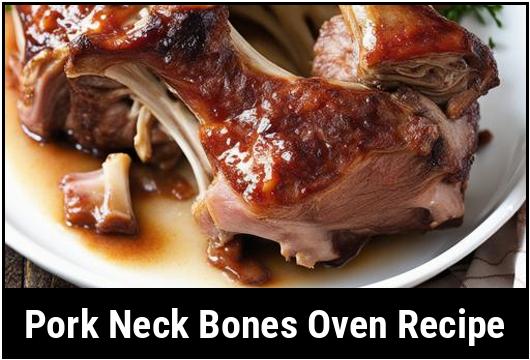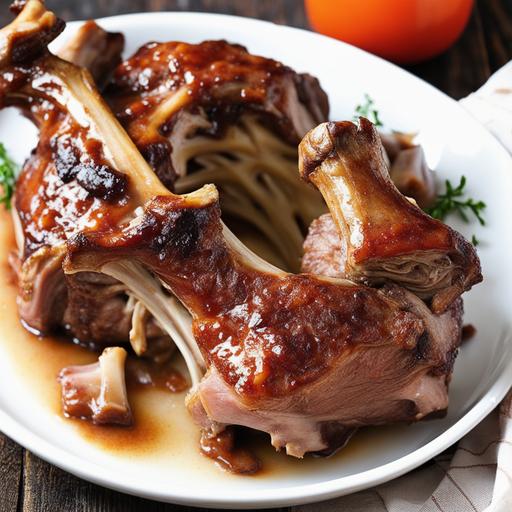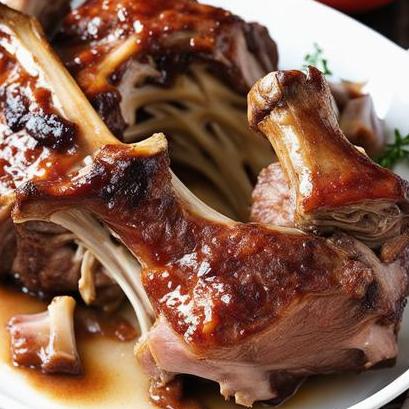
Pork Neck Bones Oven Recipe: The Ultimate Guide To Flavorful Delights
Welcome to our comprehensive guide on cooking the perfect pork neck bones in the oven. In this article, we will delve into the fascinating world of food science, culinary details, selection, cleaning, preparation, tips, variations, doneness checks, and everything else you need to know to create a succulent and tender dish. Prepare yourself for an enlightening journey into the realm of flavorful delights!
The Magic of Pork Neck Bones
Pork neck bones are a treasure trove of flavor and succulence. These humble cuts, once considered undesirable, have recently gained popularity among culinary enthusiasts for their ability to transform into meltingly tender and richly flavored delights when cooked properly. The bones, from the neck area of the pig, contain connective tissues and collagen, which, when slow-cooked, break down into gelatin, resulting in a luscious and deeply flavored dish.
Selection of Pork Neck Bones
When choosing pork neck bones, it is crucial to select cuts with a generous amount of meat attached. The bones themselves should be well-trimmed and of high quality. Look for cuts that have a vibrant pink color, ensuring freshness and tenderness. Also, make sure to purchase from a trusted butcher or reputable grocery store to guarantee optimum quality.
Cleaning and Preparation

Cleaning
Before diving into the culinary adventures, let’s start by cleaning pork neck bones to ensure food safety and hygiene. Thoroughly rinse the bones under cool running water, gently scrubbing them with a soft brush. This will remove any lingering impurities or bone fragments.
Preparation
To maximize the flavor and tenderness of pork neck bones, a well-thought-out preparation is crucial. Begin by patting the bones dry with paper towels to ensure a good sear during cooking. Now, let’s move on to the exciting part – seasoning the bones!
Seasoning the Pork Neck Bones
Seasoning is the key to transforming ordinary pork neck bones into a mouthwatering delicacy. Prepare a flavor-packed marinade or rub to infuse the bones with an explosion of taste. Here’s a simple and irresistible marinade recipe:
Marinade Ingredients:
-
2 tablespoons soy sauce
-
2 tablespoons Worcestershire sauce
-
2 cloves garlic, minced
-
1 teaspoon smoked paprika
-
1 teaspoon dried thyme
-
1 teaspoon ground black pepper
Directions:
-
Combine all the marinade ingredients in a bowl and whisk until well incorporated.
-
Place the clean and dry pork neck bones in a Ziploc bag or a shallow dish.
-
Pour the marinade over the bones, ensuring they are well-coated.
-
Seal the bag or cover the dish with plastic wrap, and marinate in the refrigerator for at least 2 hours or overnight for best results.
This marinade will infuse the pork neck bones with a harmonious blend of umami, smokiness, and earthy flavors, making them irresistibly delicious.
Preparing for the Oven
With the pork neck bones marinated to perfection, it’s time to move on to the cooking process itself. Preheating the oven is an essential step to ensure even cooking and caramelization of the meat.
Oven Preheating
-
Preheat your oven to 325°F (163°C) to achieve a slow and gentle cooking process for the most tender results.
-
While the oven preheats, remove the pork neck bones from the marinade, allowing any excess liquid to drain off.
-
Place the bones on a baking sheet lined with aluminum foil or a wire rack set in a roasting pan to elevate the bones and promote air circulation.
Cooking the Pork Neck Bones

Now, let the magic happen as the oven works its wonders on the pork neck bones. The slow and gentle cooking method will allow the collage to break down, resulting in fall-off-the-bone tenderness.
The Ideal Cooking Time and Doneness Checks
Pork neck bones should be cooked slowly over low heat to achieve optimum tenderness. The ideal cooking time may vary, but a general guideline is to cook the bones for approximately 2.5 to 3 hours. However, cooking times can be influenced by factors such as bone size, oven temperature, and personal preference.
It is important to check the doneness of the bones to ensure they are cooked to perfection. Gently pierce the meat with a thin knife or fork; if it goes through smoothly with no resistance, the bones are ready. Another technique is to check if the meat readily separates from the bone. Remember, don’t rush the cooking process – low and slow is the way to go!
The Art of Variations and Accompaniments
Cooking is a canvas for creativity, allowing you to experiment with various flavors, herbs, and spices. While the basic recipe for pork neck bones is already delicious, here are a few variations and accompaniments to explore:
1. Spiced Asian-inspired Pork Neck Bones:
-
Replace the Worcestershire sauce with hoisin sauce for a touch of sweet and salty Asian flavors.
-
Add grated ginger, chopped scallions, and a splash of rice vinegar to the marinade for an aromatic twist.
-
Serve the cooked bones with steamed jasmine rice and stir-fried bok choy for a complete meal.
2. Smoky BBQ Pork Neck Bones:
-
Utilize a barbecue rub instead of the marinade for mouthwatering smoky flavors.
-
Baste the bones with your favorite barbecue sauce during the cooking process for a sticky and tangy glaze.
-
Serve alongside coleslaw, cornbread, or grilled corn for an authentic barbecue experience.
Don’t be afraid to embrace your culinary creativity and experiment with flavors that excite your taste buds!
The Perils of Overcooking and Undercooking
While we strive for tender and succulent results, it is crucial to avoid the pitfalls of overcooking or undercooking the pork neck bones.
Overcooking:
Overcooking pork neck bones can lead to dry and tough meat, robbing it of its delicious flavors. To prevent this catastrophe, monitor the cooking time closely and adjust if necessary. If the meat appears to be drying out, you can cover the bones with aluminum foil or lower the oven temperature slightly to maintain moisture.
Undercooking:
Undercooking pork neck bones can result in chewy and unpleasantly tough meat. To avoid this mishap, ensure you check the doneness of the bones using the techniques mentioned earlier. Remember, cooking times may vary, so trust your instincts and adapt as needed.
Serving and Enjoying the Flavorful Delights
Congratulations! You have successfully cooked the most tender and flavorful pork neck bones in the oven. Now it’s time to savor the fruits of your labor.
Serving Suggestions:
-
Serve the pork neck bones alongside your favorite side dishes such as mashed potatoes, roasted root vegetables, or crusty bread to soak up the rich juices.
-
Garnish with freshly chopped parsley or cilantro for a burst of freshness, and a squeeze of lemon or lime to add a hint of acidity.
-
Transfer the flavorful cooking juices to a serving bowl or sauceboat for an extra touch of flavor. Drizzle it over the bones or side dishes for an additional burst of indulgence.
Conclusion
Pork neck bones may have once been overlooked, but they have emerged as a true sensation in the culinary world. With their abundance of flavor, tenderness, and versatility, they offer an exceptional foundation for a variety of dishes.
By following the techniques and tips outlined in this guide, you are now equipped with the knowledge to create succulent and tender pork neck bones in the oven. Remember, the key ingredients for success are patience, creativity, and a dash of culinary passion. So, embark on this delicious journey and let your taste buds relish in the wonders of pork neck bones!
Enjoy your flavorful delights, and happy cooking!
Sources
FAQS On Pork Neck Bones Oven Recipe
What Are Pork Neck Bones?
Pork neck bones are cuts of pork that come from the neck area of the pig. They are known for their rich and flavorful meat, as well as their tender texture. These bones are often used in various culinary preparations, particularly in slow-cooked dishes, due to their ability to release collagen and impart a delightful taste to stews, soups, and oven recipes.
How Long Should I Cook Pork Neck Bones In The Oven?
When using the oven to cook pork neck bones, it is recommended to cook them at a low temperature for an extended period. This slow cooking method helps break down the tough connective tissues, resulting in tender and succulent meat. Generally, cooking at 325°F (163°C) for approximately 2 to 3 hours allows the flavors to develop and the meat to become fully cooked.
What Ingredients Should I Use To Enhance The Flavor Of Pork Neck Bones In The Oven?
To enhance the flavor of your pork neck bones in the oven, consider using a combination of aromatic herbs and spices. Some popular choices include garlic, thyme, rosemary, bay leaves, and paprika. Additionally, you may use a variety of liquids, such as broth, wine, or even apple cider, to provide depth and richness to the dish. Remember to season with salt and pepper to taste.
Can I Prepare Pork Neck Bones In Advance?
Absolutely! Pork neck bones can be prepared in advance to save time and allow the flavors to further develop. After cooking the neck bones in the oven, you can refrigerate them for up to 2 days. This not only allows for easy reheating, but it also intensifies the flavors as the meat continues to absorb the seasonings.
What Are Some Serving Suggestions For Pork Neck Bones Cooked In The Oven?
There are several ways to enjoy pork neck bones cooked in the oven. One popular option is to serve them alongside your favorite sides, such as mashed potatoes, roasted vegetables, or a hearty salad. Another delicious serving suggestion is to shred the meat from the bones and use it in tacos, sandwiches, or sliders. The rich, flavorful meat pairs exceptionally well with bold and tangy condiments such as barbecue sauce or pickles.


